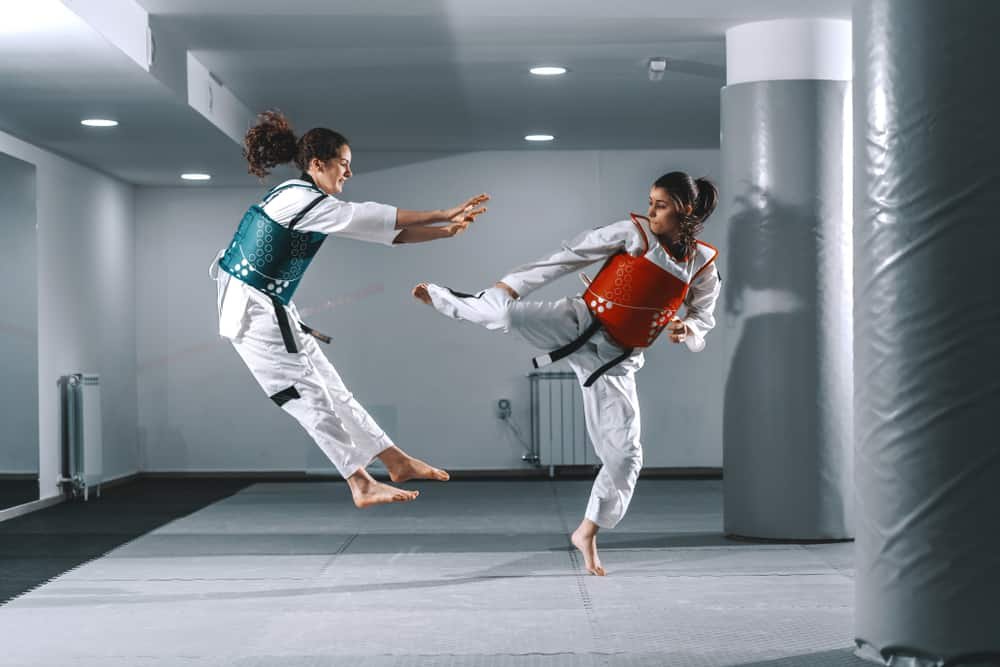
When you think of Taekwondo as a highly effective form of self-defense, it’s quite difficult to entertain the idea that it can pose a risk or be disadvantageous to those who practice it. However, there are several sources out there that warn of the risks involved. Are they true? Some of them do, in fact, hold quite a bit of “water”.
Whether you are interested in getting involved in Taekwondo yourself or want to sign your kids up for classes, it’s best to be aware of both the pros and cons. Let’s consider the risks and how to avoid falling victim to them.
These are 10 plus risks and disadvantages of Taekwondo:
1. Head injuries.
CBS News reports that in martial arts in general, injuries average from 41 to 133 injuries for every 1000 exposures to the art. This isn’t just focused on Taekwondo, but it certainly forms part of the statistics.
Taekwondo is actually a full-contact sport. In some classes, movements and strikes/impacts are mimicked rather than actually carried out. In competitions and tournaments, this isn’t always the case. A kick to the head can often result in a head injury.
Most associations take this very seriously, and if you are in a competition and get a kick blow to the head; you won’t be able to participate for a full 3 months. If it happens again after the 3-month break, you won’t be able to participate for a full 6 months. This can be detrimental to progressing in the art.

To avoid head injuries, make sure that you join classes that disallow real kicks and blows to the head. Also, wear protective headgear.
2. Bruises.
Bruising is common in Taekwondo practice, especially in the beginning phases. As you progress, bruising occurrences should decrease. So, where does the bruising come from? Sparring with other members of your club will cause such. These come from kicks and strikes to the body.
The bruising is often mild but can be as extreme as deep bruising, such as cored thighs. You can treat bruising with a cold compress, and focus on improving your strategy in order to avoid strikes and impacts.

3. Occasionally leads to a false sense of security.
When attending beginner classes, you will find that, on certain occasions, classes can have both young kids and adults learning together. This might not seem like a problem, but an adult earning a black belt is certainly more powerful and strategic than a 10-year old kid is.
Kids earning status at a very early age often get a false sense of security. They believe that they could defend themselves in a confrontation with someone who is perhaps far bigger or more dangerous. Often this leads to people putting themselves in situations they cannot handle, just because they feel secure (falsely).
4. Difficult to incorporate in a real-life fight (street fight).
Taekwondo is a great form of self-defense against someone who cannot fight at all or someone who has been learning Taekwondo and fights by “the rules”. However, it’s not a very good defense mechanism in a street fight. You might wonder why this is.
Well, the reality is that Taekwondo focuses a lot of attention on powerful kicks and doesn’t focus much on using the hands. This means that in close proximity, a fight would be difficult to win. It’s sometimes a great idea to learn other forms of martial arts before or alongside Taekwondo, or to avoid getting yourself into street-fight scenarios.

5. Possibility of incomplete combat teachings.
Not everyone feels this way, but it is a generally accepted idea that Taekwondo doesn’t teach complete combat techniques. This is because it’s not taught as a sport in most instances and includes no grappling techniques at all.
You won’t learn many face punches, and most of the focus will be on kicking. These are techniques that are extremely useful in a street fight type of confrontation. If you want to avoid feeling ill-equipped, include some upper body strength training and combat techniques that focus on the hands and arms, while also learning Taekwondo.
6. Strains and body injuries.
There are several injuries that can result from an aggressive practice. Taekwondo has a few “common” injuries to expect.
One is a broken nose, which usually results from a powerful kick to the face. When striking boards and tiles, students can fracture their carpal bones, which can be painful and difficult to recover from. Then, of course, there are typical bruises and muscle strains to expect. The moves are new to the newbie and often overstretching, or poor technique can result in strain and ultimate pain.
7. Takes a long time to learn and master.

You cannot expect to master Taekwondo in a few months. It takes a really long time to learn the moves and techniques and put them into practice. In general, the time required to advance in each rank is:
- 1st Degree Black Belt – 2 years.
- 2nd Degree Black Belt – 2 years.
- 3rd Degree Black Belt – 4 years.
- 4th Degree Black Belt – 4 years.
- 5th Degree Black Belt – 6 years.
Thereafter, it takes around 6 years for every level achieved. In reality, it can take more than 30 years to reach a 9th Degree Black Belt. As you can see, Taekwondo is a life commitment, not just a pastime.
8. Leaves little time for much else (requires a lot of time).
This is very similar to the above point but helps to illustrate that a love of Taekwondo doesn’t leave much room for anything else in your life. You cannot expect to join Taekwondo classes and have a life that is jam-packed with other activities and hobbies. Those who practice Taekwondo find that it very quickly becomes their life.
To avoid feeling as if you have no time for real life, make sure that Taekwondo is something that you can dedicate a large portion of your time to. Also, try to form a “family” and close relationships with the people that you practice with. This will eliminate the feeling of missing out on life as you will all be in it together and have a similar mindset.
9. Potential to lead to frustration.
During practices, students may be able to work off some inner frustrations, but it can get tough learning combat where no real strikes or follow-through are encouraged. In a particularly aggressive combat situation, students may feel frustrated.

10. Risk of leading to overconfidence in confrontations.
While learning on the mat, students use the correct stance and techniques to carry out movements and spar with other students.
In a real-life confrontation, students who have only ever practiced on the mat may have a bit of overconfidence. They may not take into consideration a completely different terrain that is uneven and with obstacles to consider. This may make students unbalanced or unsteady on their feet which can have a negative impact on kicking ability.
To avoid this being the case in your life, try to practice your stances and techniques as often as possible and in different types of environments.
11. Can become (relatively) expensive.
When you first sign up for a Taekwondo class, your fees might seem minimal, but over the long term, they are anything but. Maybe you can get away with paying per class, but as you progress, those fees will increase.
Consider that fees increase over the years, and your commitment to Taekwondo is set to be for more than 30 years (that’s how long it might take you to reach 9th level Black Belt). You will need to buy quality padding, a uniform, and of course, other protective gear.
Most people begin practicing when they are young and grow old with the practice, which means that you will need to keep replacing these things as you go. If you don’t want your classes to become too expensive, find a school that offers affordable instruction. Think about purchasing second-hand gear for growing children and make sure that it is something that’s worth dedicating all your spare time and money to before you take the plunge.
Conclusion

You probably didn’t think of some of these possible risks and disadvantages before, did you?
While the risks are not many, it is important to know that there are some disadvantages to including Taekwondo in your life. At the end of the day, Taekwondo isn’t for everyone, but if you are willing to dedicate a lot of time to it and are willing to focus on practicing it the right way, it can add value to your life, and you can minimize the risks.
